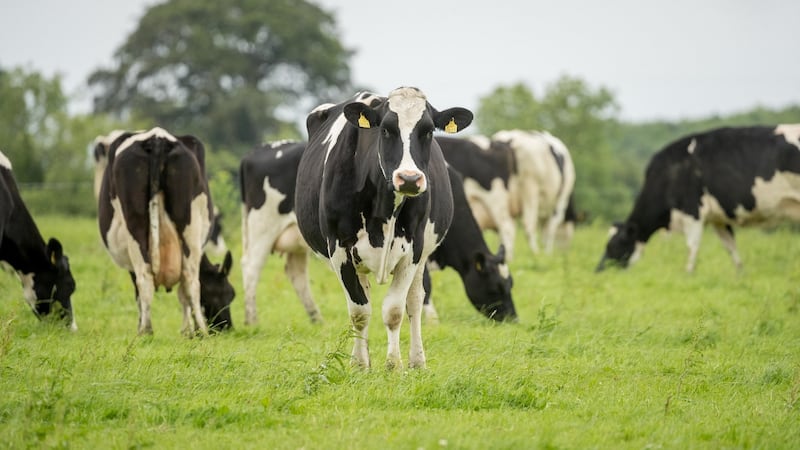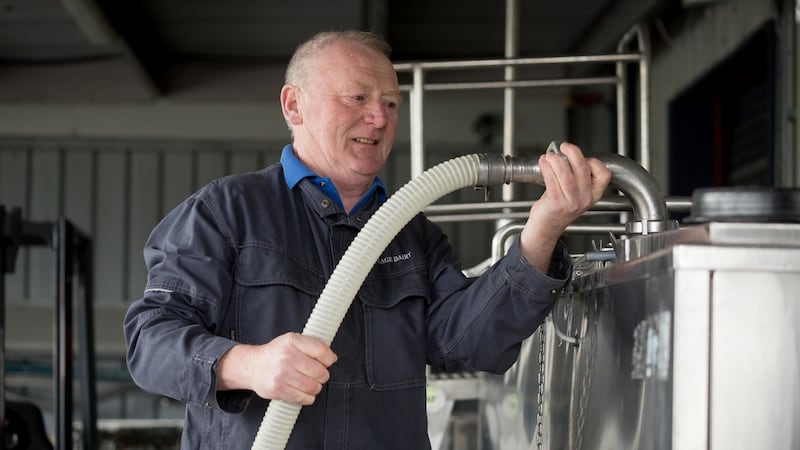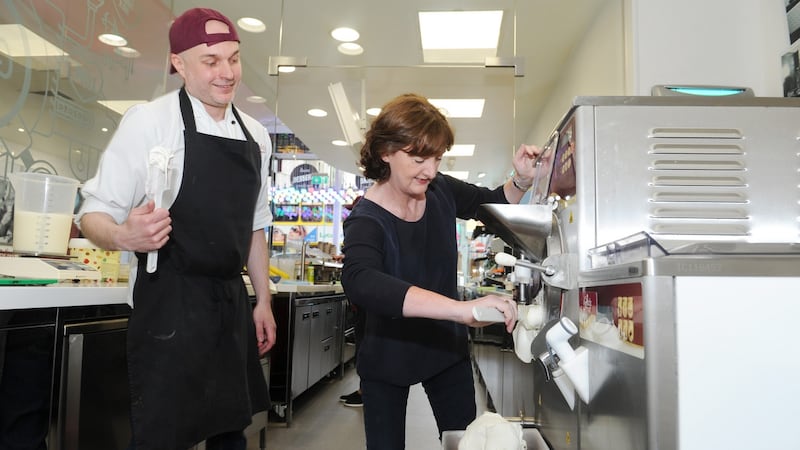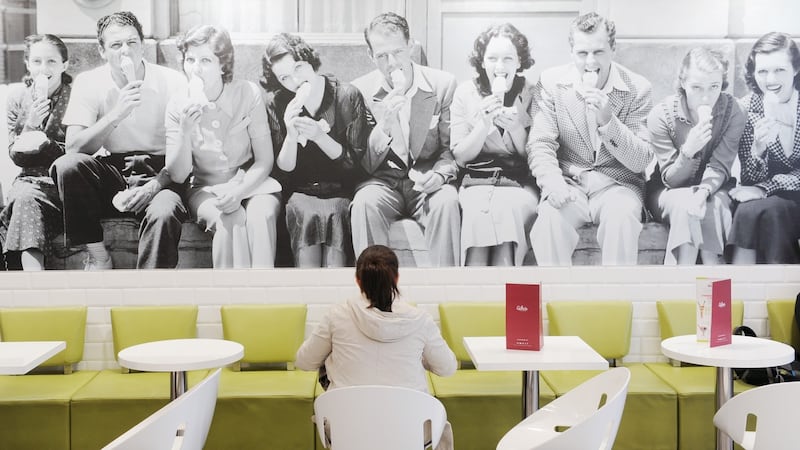The sound of a dairy cow’s post-milking moo – a deep, self-satisfied rumble of relief – is a glorious thing to encounter on a wet, cold morning, when ice-cream is the last thing on anyone’s mind. But it is also the soundtrack to the opening scenes in a 24-hour process that will see this organic milk and cream make its way from a Co Carlow farm to a Dublin city centre gelato shop.
If it is not sold on the day it is made, the gelato will be given to staff or disposed of. So it is with a measure of trepidation that I decide what flavour I am going to make in this cow-to-cone journey that will follow the milk from here to the shop counter. Those cows work too hard making that lovely milk for it to go to waste.
White chocolate and raspberry is a safe flavour. It should sell well when it hits the display cabinet in Gino’s Gelato on South Great George’s Street in Dublin. But first there is milking to be done.

Bill George of Coolanowle farm in Co Carlow is one of two suppliers of organic milk and cream to Gino's. He is on holidays when I visit the farm, and morning milking is in the hands of farm relief worker Brendan Langton, who shepherds the farm's 120 black and white Friesians through the 90-minute process in the original stone-built milking parlour.
The cows know the drill. They do it twice a day, walking placidly into the 16-stall parlour and taking their turn at the pumps. There are nuts of animal feed in the mangers at the head of each stall. “It’s like giving a child sweets,” Langton tells me. Keeping the cows relaxed means more milk, “and it also means I’m not going to be kicked”, he says from the sunken pit where he attaches the vacuum pumps to each udder.
Parlour games
Next month they will move to a new parlour across the yard, which is nearing completion, and the twice-daily milking will be done in less than an hour. But there’s something very charming about the original parlour, from where the cows file out in an orderly queue, stopping off for a munch of silage in an adjacent barn before ambling up a laneway back to their field, all in their own time.

Back in the yard there is a greater sense of urgency. Des Hurley from the Village Dairy in Killeshin, about a 10-minute drive from the farm, has arrived to collect that morning's milk. The milk he collects here today will be part of the first consignment going to the UK, where Anthony Murphy and Jonathan Kirwan, who own Gino's, are in the process of opening a chain of shops.
“We opened our first UK shop last week in Chester, and we weren’t happy with the quality of the product – as in, how it tasted,” Murphy says. The fathers of both men were in the ice-cream van business, and their joint-venture continues the family tradition. It’s safe to say they know their gelato from their ice-cream.
“What concerned me first was the price of the organic milk over there,” Murphy continues. “It was half the price, which told me straight away the quality couldn’t be as good. The cream over there was like milk; it tasted like milk.”
Considerable expense
The cost of transporting Irish organic milk to the UK will be considerable, and the company is already getting customer feedback that the £3.30 per scoop they are charging there is too expensive. But Murphy and Kirwan, who now have 14 shops in Ireland and plan to open six in the UK in the next 12 months, believe the extra cost is reflected in the quality of the product.

But first, before it heads for the UK, and to the gelato shop in Dublin where I will meet up with it again, the milk has to be processed. First, it is checked for antibiotics, before it even enters the dairy. It then passes through a process of pasteurisation and homogenisation, before being packaged, ready for delivery. The entire process takes less than two hours.
The dairy works with 14 local farms, says Kenny Hurley, plant and production manager. It also processes milk from a Jersey herd in Co Meath, and a goat herd in Mullingar. It is a small concern: it currently has 261 customers, general manager Noel Briscoe says, and supplies the Avoca stores, Butler's Pantry, Dunnes Stores and speciality coffee shops such as 3fe, as well as Gino's, which buys 6,000 litres of organic milk and 300 litres of organic cream from it every week.
100 kinds of gelato
Fast-forward 24 hours, and the Coolanowle milk is being pasteurised a second time, as part of the process involved in turning it into gelato. It was delivered to Dublin at 7am that morning, in giant 12.3 litre bag-in-a-box containers. Cream, and a premixed base made for Gino’s which contains sugar and skimmed milk powder, among other things, are added. This forms the base mixture for the almost 100 varieties of gelato the shops can make.

There are about 18 varieties on sale in the George’s Street shop every day (Henry Street has 27), and there are a couple of empty steel containers, awaiting new stock, including my white chocolate and raspberry. Nothing original about my choice – they’ve already had it on the menu, and it should sell well, I’m told. Which is just as well, as we’re about to make five litres of it, or around 50 standard scoops.
I am taken through the process by Slovenian former graphic designer Jan Jariabka, who is the company's chief gelato maker, and staff trainer. It takes only 20 minutes to churn and chill the giant batch of white chocolate gelato, to which we then add raspberry variegato, or ripple, as well as whole raspberries. This is done in stages to make sure the fruit is evenly distributed, and the tower of gelato is gradually built up into a bountiful display.
Each shop has its own gelato maker, and Jariabka, who spent six years learning how to make it, explains that part of the skill is in knowing just how much to make, because if not sold on the day it is made, it will be discarded. The day of the week, and the weather, are factors in the calculations, and 17 degrees is the tipping point, at which point sales go up.
No takers
It’s a hot and muggy day in Dublin, but still there is no great rush to buy my white chocolate and raspberry creation. The Kinder Bueno- and Ferrero Rocher-inspired varieties are the shop’s perpetual bestsellers, Jariabka says.

There isn't as big a range of fruit flavours on offer in Gino's you'd see in Italy, and that is down to customer preference, which is a regional thing, even between Ireland and the UK.
“We had to take rum’n’raisin off here because it didn’t sell,”Murphy says. “But we are already being asked for it in the UK, so we will have to have it there.”
Consumer preference is notoriously fickle – why is nobody ordering my white chocolate raspberry? – but one thing Murphy and Jariabka are sure of is that Irish gelato is superior to the Italian stuff.
“Because of the quality of the grass, the milk is very rich, which adds an extra kick to the gelato,” Jariabka says. For Murphy, it also comes down to the organic milk those happy cows in Co Carlow are producing, and that’s why Gino’s is sticking with organic Irish milk.
GELATO OR ICE-CREAM: WHAT’S THE DIFFERENCE?
Gelato often does not contain eggs, ice-cream made with a custard base does.
Gelato is stored and served at a higher temperature than ice-cream, approximately -14 compared with -22.
Gelato has less fat (and sometimes more sugar) than ice-cream.
Gelato is denser than ice-cream, as less air is incorporated in the churning process.











